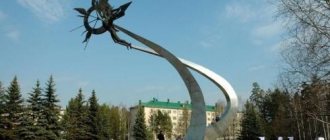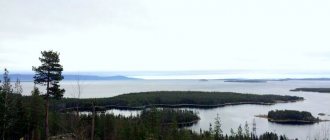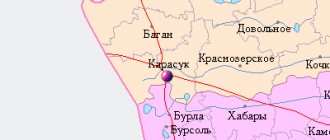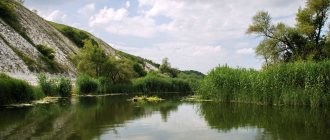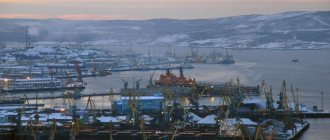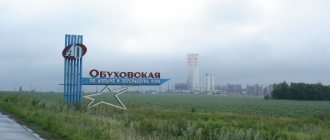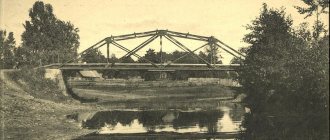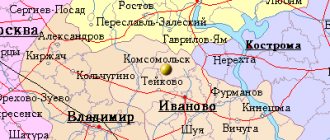This term has other meanings, see Olenegorsk (meanings).
| City | |
| Olenegorsk | |
| Flag | Coat of arms |
Moscow
Murmansk
Olenegorsk
Media files on Wikimedia CommonsOlenegorsk
- a city (since 1957) in the Murmansk region of Russia. The center of the municipal district is the city of Olenegorsk with its subordinate territory. Located 94 km south of Murmansk.
By Order of the Government of the Russian Federation dated July 29, 2014 No. 1398-r “On approval of the list of single-industry towns,” the city was included in the category “Single-industry municipalities of the Russian Federation (single-industry towns) in which there are risks of deterioration of the socio-economic situation”[2].
Population - 19,887[1] people. (2021).
Population
| Population | ||||||||
| 1959[4] | 1967[5] | 1970[6] | 1979[7] | 1989[8] | 1992[5] | 1996[5] | 1998[5] | 2000[5] |
| 12 110 | ↗20 000 | ↗21 485 | ↗27 369 | ↗35 584 | ↗35 800 | ↘30 400 | ↘28 900 | ↘27 200 |
| 2001[5] | 2002[9] | 2003[5] | 2005[5] | 2006[5] | 2007[5] | 2008[5] | 2009[10] | 2010[11] |
| ↘26 600 | ↘25 166 | ↗25 200 | ↘23 900 | ↘23 600 | ↘23 100 | ↘22 900 | ↘22 435 | ↗23 072 |
| 2011[12] | 2012[13] | 2013[14] | 2014[15] | 2015[16] | 2016[17] | 2017[18] | 2018[19] | 2019[20] |
| ↘22 986 | ↘22 405 | ↘21 736 | ↘21 301 | ↘21 003 | ↗21 097 | ↘21 039 | ↘20 847 | ↘20 697 |
| 2020[21] | 2021[1] | |||||||
| ↘20 364 | ↘19 887 | |||||||
As of January 1, 2022, in terms of population, the city was in 666th place out of 1116[22]cities of the Russian Federation[23].
The population living in the territory of the settlement, according to the 2010 All-Russian Population Census, is 23,072 people, of which 10,469 are men (45.4%) and 12,603 are women (54.6%)[24][25].
Transport
Square of the city of Olenegorsk
All urban and suburban public transport in Olenegorsk is represented by route No. 105, which follows the route “Mira Street - Station Square - Vysoky village”.
The city also has the Olenegorsk railway station, where long-distance trains and the Apatity-Murmansk electric train stop. An electrified single-track line departs from the station to Monchegorsk, used for freight traffic (passenger service was canceled in the early 1990s), as well as a diesel locomotive line to the Olenya military air base in the village of Vysoky and access roads to industrial enterprises.
History[edit]
Oleniy railway station
(Olenya) was opened in 1916 for the construction of the Murmansk Railway. The station buildings and a small village associated with the station were located east of the railway. Their importance increased somewhat in the 1930s when Olenya became the junction of a railway line to the newly built town of Monchegorsk about 30 kilometers (19 mi) to the southwest.
In 1949, work began on open-pit mines and iron ore processing plants a few kilometers west of Olenya station. At the same time, between the railway station and the mines, to the west of the railway, construction began on a company town, originally also called Oleni. In December 1949, it was given the status of a workers' settlement.
By a resolution of the Presidium of the Supreme Soviet of the RSFSR dated March 27, 1957, the working village of Olenya received the status of a city of regional subordination, subordinate to Monchegorsk, and received its current name. [2] The railway station, however, retained the name Olenya and was not renamed Olenegorsk until the 1980s. [ citation needed
] By the Decree of the Presidium of the Supreme Soviet of the RSFSR of August 10, 1981, Olenegorsk received the status of a city of regional subordination, and by August 26, several settlements that were previously subordinate to Monchegorsk were transferred to Olenegorsk. 1981 Decision of the Murmansk Regional Executive Committee. [10]
Economy
- Olenegorsk Mining and Processing Plant is developing the Olenegorsk iron ore deposit.
- OJSC Olenegorsk Mechanical Plant produces spare parts and non-standardized equipment for mining and metallurgical enterprises.
- The Olenegorsk (Olenya) airbase is located in the village of Vysoky, beyond Lake Permusozero east of the city.
- PJSC Olenegorsk Sand-Sand Brick Plant produces sand-lime and ceramic bricks, aerated concrete blocks, building mixtures and various concrete products.
Visiting the Sami
On the site of Olenegorsk there was once a Sami settlement. Alas, now you hardly see Sami in the city. To get acquainted with the life of the aborigines of the Kola Peninsula, you can go to the Oleniy Bereg agricultural village. It is located 10 kilometers from the city on the shores of Lake Hare. Deer, huskies, rabbits - it's all here. You can ride deer and dogs. There is a guest house. Visitors are offered trips on ATVs and snowmobiles. In these places you can really see the northern lights.
You can go dog sledding in the agricultural village
Another interesting place associated with the Sami is located in the village of Lovozero, 84 kilometers from Olenegorsk. The open-air museum “Sam Syyt” is located here. In fact, it is a recreated Sami village. Tourists are offered a three-hour excursion. The program includes a visit to traditional Sami buildings - tents, vezhi, kuvaks. On the alley of idols, guests make wishes.
Sami ethnographic complex
There is a mini-zoo on the territory where moose, huskies, foxes, arctic foxes and rabbits live. Animals are fed by hand. In summer, guests visit the picturesque spring lake “Seven Springs of the Sami”. You should definitely play the national Sami games - pole tug-of-war, “deer and wolves”, reindeer antler throwing and others.
In winter, the excursion includes riding a reindeer sleigh or riding a snowmobile in a sleigh. There is an opportunity to ride with the breeze on a “banana”, which is attached to a snowmobile. Or fly down the slide on the ice. In summer, ATVs are used as a means of transport. At the Petroglyphs cafe they serve lim (salmon fish soup), the Sami drink “pakula” and Lovozero bread. You should definitely try “kull-värr” - floury fish soup.
Those interested can take pictures in national clothes
Those who wish can take pictures in national Sami clothing. Tourists buy amulets and charms as souvenirs. There is a guest house and apartments in the village. There is a sauna for six people. Fishing and picnics can be organized for guests. Cost of the excursion: adults – 1550 rubles, children – 1300 rubles.
Education
| The section lacks links to sources. Information must be verifiable or it may be deleted. You can edit the article to add links to authoritative sources. This mark was set on May 12, 2011 . |
Until 1997, there were 5 secondary schools in the city; in 2003, school No. 2 was closed; in 2008, the work of the remaining 4 schools was transformed: all 10-11 grades continued their education on the basis of school No. 4 in its “second building” - previously school No. 15. Schools No. 21 and No. 7 continued to operate as basic comprehensive schools (junior secondary schools) .
Also in the city there is a music and art school and the Olenegorsk Mining and Industrial College (until 2006 - vocational school No. 20).
Everything for tourists
The city has a museum and exhibition hall “At the Deer Mountain”. The permanent exhibition includes an exhibition of Sami arts and crafts. There is a section dedicated to the history of the city and the mining and processing plant. “Amazing stones”, “The path of a geologist. Life and work of A.E. Fersman”, “They built our city” - the names of the exhibitions speak for themselves.
The museum has a section “Amazing Stones”
The museum regularly hosts folklore and ethnographic evenings “In a warm cozy tent”, “Christmas gatherings” and others. Visitors are taught carols and ritual songs, and treated to national cuisine. Adults and children participate in theatrical performances. Every year on February 6, International Sami Day, the exhibition “Sami Patterns” is organized. It presents handmade items. Rotating photo and art exhibitions are held regularly.
In the Sami plague
The city-forming enterprise is the Olenegorsk mining and processing plant. In Russia it is considered the northernmost producer of iron ore concentrate. Ore is mined in six quarries. Olenegorsky is considered the largest. Its depth reaches 400 meters. For comparison, the maximum depth of the Azov Sea does not exceed 14 meters. Excursions are organized to the plant’s work site, during which you can observe the mining equipment in action.
You can get acquainted with the Olenegorsk Mining and Processing Plant during a tour
Near Olenegorsk lies the Simbozersky reserve. Its task is to protect rare animals of the Kola Peninsula. Here, in particular, are the wintering grounds of moose. The reserve is even called a maternity hospital for moose. Visitors are offered excursions, as well as trips on ATVs and snowmobiles. Hunting in the reserve is prohibited, but picking mushrooms and berries is allowed.
Wintering grounds for moose are located in the Simbozersky Nature Reserve.
During the year, Olenegorsk hosts seven festivals. The “track” is designed for young people. This is breakdancing, rap, rock, art song and folklore in one “bottle”. January is the time of the New Year's festival "Morozko". The fact is that in 1964, the famous film “Morozko” was filmed in the outskirts of the city. Hence the name of the holiday. The townspeople then took part in the crowd scenes. The director of the local sports complex even acted as a stunt double.
In February there is a soldier's song competition. It is dedicated to the anniversary of the withdrawal of Soviet troops from Afghanistan. The festival of Sami music and culture falls in April. The program includes national songs, dances, reindeer riding, and an exhibition of handicrafts. The Gates of the Sun festival starts in mid-May. It is dedicated to Slavic writing. On this day, all kinds of master classes take place on the square. In August, the rock festival “METALurg” thunders, and in September the “Three Mountains” motorcycle competition starts.
Seven festivals are held in Olenegorsk throughout the year.
You can stay overnight in Olenegorsk at the only hotel “Gornyak”. A more economical, but spartan option is the Shakhtar hostel. The Ice Palace has guest rooms. The best option is to rent an apartment in the city center. There are also hotels in the neighboring city of Monchegorsk.
You can have fun and have a snack at the same time in the “Territory” art hall. Guests have at their disposal a kicker, table tennis, Monopoly game, and air hockey. The popular cafes are “Veranda”, “Drova”, “Three Sauces”, “Yin-Yang”.
Notes
- ↑ 123
The permanent population of the Russian Federation by municipalities as of January 1, 2022 (Russian). Retrieved April 27, 2022. Archived May 2, 2022. - Order of the Government of the Russian Federation of July 29, 2014 No. 1398-r “On approval of the list of single-industry towns”
- Climate-Data.org
- All-Union Population Census of 1959. The size of the urban population of the RSFSR, its territorial units, urban settlements and urban areas by gender (Russian). Demoscope Weekly. Access date: September 25, 2013. Archived April 28, 2013.
- ↑ 1234567891011
People's encyclopedia "My City". Olenegorsk - All-Union Population Census of 1970 The size of the urban population of the RSFSR, its territorial units, urban settlements and urban areas by gender. (Russian). Demoscope Weekly. Access date: September 25, 2013. Archived April 28, 2013.
- All-Union Population Census of 1979 The size of the urban population of the RSFSR, its territorial units, urban settlements and urban areas by gender. (Russian). Demoscope Weekly. Access date: September 25, 2013. Archived April 28, 2013.
- All-Union population census of 1989. Urban population (undefined)
. Archived from the original on August 22, 2011. - All-Russian population census 2002. Volume. 1, table 4. Population of Russia, federal districts, constituent entities of the Russian Federation, districts, urban settlements, rural settlements - regional centers and rural settlements with a population of 3 thousand or more (unspecified)
. Archived from the original on February 3, 2012. - The size of the permanent population of the Russian Federation by cities, urban settlements and regions as of January 1, 2009 (unspecified)
. Retrieved January 2, 2014. Archived January 2, 2014. - All-Russian population census 2010. Volume 1 “Number, distribution and age-sex composition of the population of the Murmansk region” (unspecified)
. Access date: February 2, 2014. Archived February 2, 2014. - Murmansk region. Estimated resident population as of January 1, 2009-2015
- Population of the Russian Federation by municipalities. Table 35. Estimated resident population as of January 1, 2012 (unspecified)
. Retrieved May 31, 2014. Archived May 31, 2014. - Population of the Russian Federation by municipalities as of January 1, 2013. - M.: Federal State Statistics Service Rosstat, 2013. - 528 p. (Table 33. Population of urban districts, municipal districts, urban and rural settlements, urban settlements, rural settlements) (undefined)
. Retrieved November 16, 2013. Archived November 16, 2013. - Table 33. Population of the Russian Federation by municipalities as of January 1, 2014 (unspecified)
. Access date: August 2, 2014. Archived August 2, 2014. - Population of the Russian Federation by municipalities as of January 1, 2015 (unspecified)
. Access date: August 6, 2015. Archived August 6, 2015. - Population of the Russian Federation by municipalities as of January 1, 2016 (Russian) (October 5, 2018). Retrieved May 15, 2022. Archived May 8, 2022.
- Population of the Russian Federation by municipalities as of January 1, 2022 (Russian) (July 31, 2017). Retrieved July 31, 2022. Archived July 31, 2022.
- Population of the Russian Federation by municipalities as of January 1, 2022 (Russian). Retrieved July 25, 2018. Archived July 26, 2022.
- Population of the Russian Federation by municipalities as of January 1, 2022 (Russian). Retrieved July 31, 2019. Archived May 2, 2022.
- Population of the Russian Federation by municipalities as of January 1, 2022 (Russian). Date accessed: October 17, 2022. Archived October 17, 2022.
- taking into account the cities of Crimea
- https://rosstat.gov.ru/storage/mediabank/bul_Chislen_nasel_MO-01-01-2021.rar Population of the Russian Federation by municipalities as of January 1, 2022 (1.85 Mb, 07/30/2021)
- Statistical collection Number, distribution and age-sex composition of the population of the Murmansk region. Results of the All-Russian Population Census. Volume 1. 2012 (unspecified)
. Archived from the original on December 22, 2012. / Federal State Statistics Service, Territorial body of the Federal State Statistics Service for the Murmansk region. Murmansk, 2012 - 75 p. - Population of the Murmansk region by gender as of October 14, 2010 (unspecified)
(inaccessible link). Access date: September 7, 2012. Archived July 26, 2013.

